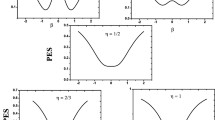Abstract
In the framework of the interacting boson model (IBM) with intrinsic coherent state, the shape Hamiltonian from spherical vibrator U(5) to axially symmetric prolate deformed rotator SU(3) are examined. The Hamiltonian used is composed of a single boson energy term and quadrupole term. The potential energy surfaces (PES’ s) corresponding to the U(5)-SU(3) transition are calculated with variation of a scaling and control parameters. The model is applied to 150–162Dy chain of isotopes. In this chain a change from spherical to well deformed nuclei is observed when moving from the lighter to heavier isotopes. 156Dy is a good candidate for the critical point symmetry X(5). The parameters of the model are determined by using a computer simulated search program in order to minimize the deviation between our calculated and some selected experimental energy levels, B(E2) transition rates and the two neutron separation energies S2n. We have also studied the energy ratios and the B(E2) values for the yrast state of the critical nucleus. The nucleon pair transfer intensities between ground-ground and ground-beta states are examined within IBM and boson intrinsic coherent framework.
Similar content being viewed by others
References
F. Iachello and A. Arima, The Interacting Boson Model (Cambridge Univ. Press, Cambridge, UK, 1987).
Interacting Bose-Fermi Systems, Ed. by R. F. Casten and F. Iachello (Plenum, New York, 1981).
D. Warner, Nature 420, 614–620 (2002).
A. M. Khalaf, N. Gaballah, M. F. Elgabry, and H. A. Ghanim, Prog. Phys. 11, 141–145 (2015).
A. M. Khalaf and M. M. Taha, J. Theor. Appl. Phys. 9, 127–133 (2015).
A. M. Khalaf and M. D. Okasha, Prog. Phys. 10, 246–252 (2014).
A. M. Khalaf, H. S. Hamdy, and M. M. Elsawy, Prog. Phys. 3, 44–51 (2013).
A. M. Khalaf and A. M. Ismail, Prog. Phys. 2, 98–104 (2013).
A. M. Khalaf and T. M. Awwad, Prog. Phys. 1, 7–11 (2013).
R. F. Casten, Prog. Part. Nucl. Phys. 62, 183–209 (2009).
J. Barea, J. M. Arias, and J. E. Garcia-Ramos, Phys. Rev. C 82, 024316 (2010).
P. Cejnar and J. Jolic, Prog. Part. Nucl. Phys. 62, 210–256 (2009).
M. A. Caprio and F. Iachello, Nucl. Phys. A 781, 26–66 (2007).
T. Niksic, D. Vretenar, G. A. Lalazissis, and P. Ring, Phys. Rev. Lett. 99, 092502 (2007).
C. E. Alonso, J. M. Arias, and A. Vitturi, Phys. Rev. Lett. 98, 052501 (2007).
Y. Zhang, Z. F. Hau, and Y. X. Liu, Phys. Rev. C 76, 011305(R) (2007).
A. Leviatan, Phys. Rev. Lett. 98, 242502 (2007).
Y. Zhao, Y. Liu, L. Z. Mu, and Y. X. Liu, Int. J. Mod. Phys. E 15, 1711 (2006).
R. F. Casten, Nature Phys. 2, 811–820 (2006).
Y. X. Liu, L. Z. Mu, and H. Q. Wei, Phys. Lett. B 633, 49 (2006).
J. Meng, W. Zhang, S. G. Zhou, H. Toki, and L. S. Geng, Eur. Phys. J. A 25, 23 (2005).
D. J. Rowe, P. S. Tunner, and G. Rosensteel, Phys. Rev. Lett. 93, 232502 (2004).
A. Bohr and B. Mottelson, Nuclear Structure (Benjamin, New York, 1975), Vol. 2.
J. N. Ginocchio, Nucl. Phys. A 376, 438 (1982).
F. Iachello, Phys. Rev. Lett. 85, 3580 (2000).
F. Iachello, Phys. Rev. Lett. 87, 052502 (2001).
F. Iachello, Phys. Rev. Lett. 91, 132502 (2003).
D. Bonatsos, D. Lenis, D. Petrellis, and P. A. Terziev, Phys. Lett. B 588, 172 (2004).
A. E. L. Dieprink, O. Scholten, and F. Iachello, Phys. Rev. Lett. 44, 1747 (1980).
National Nuclear Data Center, Data (Brookhaven Natl. Labor., Upton, NY, USA, 2012).
Author information
Authors and Affiliations
Corresponding author
Additional information
The article is published in the original.
Rights and permissions
About this article
Cite this article
Kotb, M. U(5)-SU(3) nuclear shape transition within the interacting boson model applied to dysprosium isotopes. Phys. Part. Nuclei Lett. 13, 451–459 (2016). https://doi.org/10.1134/S1547477116040075
Received:
Published:
Issue Date:
DOI: https://doi.org/10.1134/S1547477116040075




